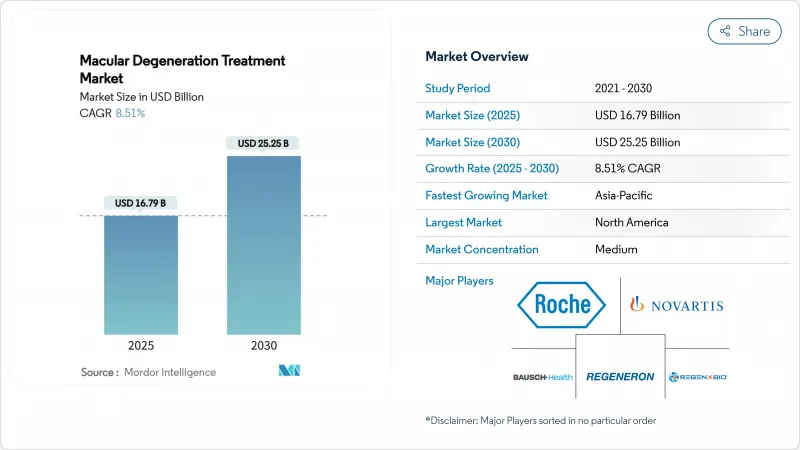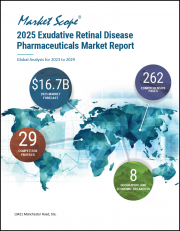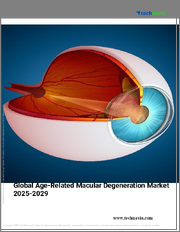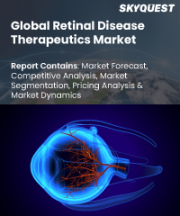
|
시장보고서
상품코드
1852206
황반 변성 치료 : 시장 점유율 분석, 산업 동향, 통계, 성장 예측(2025-2030년)Macular Degeneration Treatment - Market Share Analysis, Industry Trends & Statistics, Growth Forecasts (2025 - 2030) |
||||||
황반 변성 치료 시장 규모는 2025년에 167억 9,000만 달러로 평가되었고, 2030년에 252억 5,000만 달러에 이를 것으로 예측되며, CAGR은 8.51%를 나타낼 전망입니다.

이러한 전망은 인구 고령화, 혁신적 약물에 대한 규제 지원, 기존 안과 진료 경로보다 조기 질환 발견이 가능한 디지털 진단법의 급속한 확산을 반영합니다. 고령화 속도보다 25% 빠르게 증가하는 노인성 황반변성(AMD) 유병률, AI 기반 선별 알고리즘의 94% 민감도와 99% 특이도, 지리적 위축증 치료 옵션을 확장하는 보완 경로 억제제로의 전환이 수요 증가를 뒷받침합니다. 후기 임상시험 단계의 유전자 및 세포 치료제, 지속 방출 전달 플랫폼, 바이오시밀러 가격 경쟁이 수익 구조를 재편하는 가운데, 보험사들은 생물학적 제제 비용 억제를 위해 이용 통제를 강화하고 있습니다. 지역별로는 미국이 FDA의 혁신치료제 지정 제도를 활용해 신약에 대한 선점적 접근권을 유지하는 반면, 아시아태평양 지역은 급속한 보험급여 확대와 대규모 고령 인구층을 바탕으로 가장 빠른 단위 성장률을 기록하고 있습니다.
세계의 황반 변성 치료 시장 동향 및 인사이트
노화 관련 안구 질환 유병률 증가
장시간 화면 노출, 불량한 식습관, 증가하는 도시 오염 등 생활습관 요인이 유전적 위험을 가중시키면서 AMD(황반 변성) 유병률은 기준 노화 추세를 25% 상회하고 있습니다. WHO는 2030년까지 2억 8,800만 명이 AMD를 앓을 것으로 전망하며, 이는 의료 시스템이 진료소 기반 검진 대비 치료 가능 인구를 40% 확대하는 조기 발견 프로토콜을 도입하도록 촉진하고 있습니다. 치료되지 않은 AMD는 이미 전 세계 생산성 및 치료 비용으로 3,430억 달러를 소모하고 있어, 보험사들이 정기적 영상 검사와 영양 지원 등 예방적 치료법을 권장하도록 촉진하고 있습니다. 성숙한 진단 네트워크를 보유한 국가들은 일차 진료 기관 및 약국까지 확대되는 AI 기반 검진 도입이 급증하며, 환자를 더 빠르게 치료 파이프라인으로 유도하는 효과를 보고 있습니다. 제약사들은 선제적 치료 모델에 부합하고 진료실 혼잡을 줄이는 장기 지속형 임플란트로 대응하고 있습니다.
급증하는 글로벌 노인 인구
2030년까지 65세 이상 인구는 전 세계 인구의 16.5%를 차지할 것이며, 진행성 AMD에 가장 취약한 85세 이상 집단은 일반 노인 인구 증가율의 두 배로 확대되고 있습니다. 일본과 한국을 중심으로 한 아시아태평양 국가들은 전례 없는 수요에 직면하여 전문의 공급 부족을 초래하고 원격 안과 진료 도입을 촉진하고 있습니다. 노인 환자들은 당뇨병이나 고혈압을 동반하는 경우가 많아 항-VEGF 주사 요법을 복잡하게 만들고 더 세밀한 안전 관리가 필요합니다. 미국 메디케어의 항-VEGF 치료 지출은 2014년 25억 1,000만 달러에서 2019년 40억 2,000만 달러로 증가했으며, 비용 효율적인 대안이 없는 경우 2030년까지 두 배로 증가할 것으로 전망됩니다. 이에 정부들은 의료 인력 부족 문제를 완화하고 예산 증가를 억제할 수 있는 자가 투여제 및 가정용 모니터링 장치를 선호하고 있습니다.
생물학적 제형 및 유전자 치료의 고비용
주요 항-VEGF 주사제는 1회 투여당 1,850-2,000달러에 달하며, 연간 6-8회 투여가 일반적인 치료 계획은 진단비 및 진료비를 제외해도 1만 5,000달러를 초과할 수 있습니다. 개발 중인 일회성 유전자 치료제는 안구당 20만-50만 달러가 소요될 수 있어, 잠재적 평생 비용 상쇄 효과에도 불구하고 지불자의 심층 검토를 촉발하고 있습니다. 2024년 출시된 아플리버셉트 바이오시밀러는 정가 대비 15-30% 할인되었으나, 전환 저항과 제품별 안전성 데이터 부족으로 빠른 시장 침투가 제한되고 있습니다. 지급기관들은 단계적 치료 규정, 치료 장소 제한, 시력 유지력에 따른 보상 연계형 성과 기반 계약 시범 사업 등으로 대응하고 있습니다. 이러한 접근성 제약은 고가 치료법의 단기적 도입을 억제하며 황반 변성 치료 시장 연평균 성장률(CAGR)을 약 2%포인트 하락시킬 수 있습니다.
부문 분석
습성 AMD의 2024년 매출의 65.43%를 차지하는 것은 항-VEGF 치료법의 확고한 입지를 보여주지만, 바이오시밀러가 가격 및 판매량 점유율을 잠식함에 따라 성장 둔화가 뚜렷합니다. 경로 변화는 건성 AMD 부문에 유리하게 작용하고 있습니다. SYFOVRE와 IZERVAY의 승인으로 지리적 위축증에 대한 최초의 약리학적 치료 옵션이 등장했으며, 병변 확장을 최대 35%까지 억제합니다. 실제 임상 데이터가 안전성을 입증함에 따라 보험사 채택이 가속화되어 10.43%의 연평균 복합 성장률(CAGR)을 이끌며 황반 변성 치료 시장 전반의 포트폴리오 우선순위를 재편하고 있습니다. 유전자 치료 연구자들은 전체 AMD 환자의 약 85%를 차지하는 환자 풀과 평생 주사를 피할 수 있는 일회성 치료 제공 가능성에 매료되어 건성 AMD에 집중하고 있습니다.
경쟁적 투자는 현재 보체 조절 및 광수용체 보호로 기울어지며, 2027년까지 다양한 기전에 걸친 3상 결과 발표가 예상됩니다. 선도 기업들은 고용량 아플리베셉트와 VEGF/Ang-2 복합 억제를 통해 습성 AMD 시장 점유율 하락을 막고 있으나, 인수 및 공동 개발 계약을 통해 건성 AMD 자산으로 전략적 자본이 점차 이동 중입니다. 상업 분석가들은 건성 부문 채택률이 현재 속도를 유지할 경우 2029년까지 습성 및 건성 매출이 수렴할 것으로 전망하며, 이는 황반 변성 치료 산업 전반의 가치 평가 기준을 재조정할 이정표가 될 것입니다.
조기 AMD는 2024년 황반 변성 치료 시장 규모의 72.43%를 차지했으며, 이는 클라우드 연결 망막 카메라를 통한 1차 진료, 검안, 지역 약국 채널로의 진단 확대를 반영합니다. 안과학회는 신규 진단 환자에게 AREDS 기반 영양제 보충 및 생활습관 조정을 권장하며, 이는 기능성 식품 제조사와 원격 모니터링 업체를 지원하는 예방 의료 경제의 기반이 됩니다. 보완 인자 억제제가 병변 성장 억제 효과를 입증하고 환자의 '기능적 시력 유지 기간'을 연장함에 따라 중기 AMD는 2030년까지 10.99%의 가장 빠른 부문 연평균 성장률(CAGR)을 기록할 전망입니다. 상업적 논리는 상실된 시력 회복보다는 진행 억제에 중점을 두어, 지불 주체의 관심사와 사회적 비용 절감 효과를 일치시킵니다.
말기 AMD는 반복적 주사 일정과 보조 기기 수요로 환자당 최고 수익 단계를 유지합니다. 그러나 지속 방출 임플란트와 유전자 치료가 진료 횟수를 압축하고 기존 행위별 수수료 비즈니스 모델을 교란할 위협이 있습니다. 실시간 가정용 OCT 기기는 분류를 간소화하여 악화되는 안구만 신속한 치료를 위해 병원으로 유도함으로써, 황반 변성 치료 시장 전반에 걸쳐 진료 역량을 보존하고 정밀 의학을 발전시킵니다.
기타 혜택 :
- 엑셀 형식 시장 예측(ME) 시트
- 3개월간의 애널리스트 지원
목차
제1장 서론
- 조사의 전제조건과 시장의 정의
- 조사 범위
제2장 조사 방법
제3장 주요 요약
제4장 시장 상황
- 시장 개요
- 시장 성장 촉진요인
- 노화에 따른 안구 질환 유병률 상승
- 세계의 노년 인구의 급증
- 안구 약물 전달 기술 발전
- 신규 치료제의 강력한 후기 파이프라인
- 신흥 경제국 의료 접근성 확대
- 시력 유지를 위한 의료비 증가
- 시장 성장 억제요인
- 생물학적 제제와 유전자 치료의 고비용
- 저소득 지역의 제한된 보험 적용
- 엄격한 규제 및 안전 요건
- 만성적 치료 부담 및 환자 치료 불이행
- 규제 상황
- Porter's Five Forces 분석
- 신규 참가업체의 위협
- 구매자의 협상력/소비자
- 공급기업의 협상력
- 대체품의 위협
- 경쟁 기업간 경쟁 관계
제5장 시장 규모와 성장 예측
- 질병 형태별
- 건성 노화 황반 변성증
- 습성 노화 황반 변성증
- 병기별
- 조기 AMD
- 중간기 AMD
- 말기 AMD(지리적 위축 및 신생 혈관)
- 치료 유형별
- 의약품
- 항-VEGF 주사제
- 보체 경로 억제제
- 유전자 및 세포 치료
- 영양보조식품과 항산화물질
- 기타 의약품
- 디바이스
- 로비전 안경
- 콘택트렌즈
- 망막 이식와 시력 보조 기구
- 수술
- 레이저 광응고술
- 광역학 치료
- 기타 외과 수술
- 의약품
- 투여 경로별
- 유리체 내
- 맥락막 상막
- 정맥 내 주사
- 판매 채널별
- 병원
- 외래 외과 센터
- 전문 약국 및 소매 약국
- 지리
- 북미
- 미국
- 캐나다
- 멕시코
- 유럽
- 독일
- 영국
- 프랑스
- 이탈리아
- 스페인
- 기타 유럽
- 아시아태평양
- 중국
- 일본
- 인도
- 호주
- 한국
- 기타 아시아태평양
- 중동 및 아프리카
- GCC
- 남아프리카
- 기타 중동 및 아프리카
- 남미
- 브라질
- 아르헨티나
- 기타 남미
- GCC
- 북미
제6장 경쟁 구도
- 시장 집중도
- 시장 점유율 분석
- 기업 프로파일
- F. Hoffmann-La Roche Ltd
- Novartis AG
- Regeneron Pharmaceuticals Inc.
- Bayer AG
- Bausch Health Companies Inc.
- Alcon Inc.
- Apellis Pharmaceuticals Inc.
- Astellas Pharma Inc.(Iveric Bio)
- Samsung Bioepis
- REGENXBIO Inc.
- 4D Molecular Therapeutics
- Adverum Biotechnologies
- EyePoint Pharmaceuticals
- Ocular Therapeutix Inc.
- Lineage Cell Therapeutics Inc.
- PanOptica
- OLIX Pharmaceuticals
- ONL Therapeutics
- MeiraGTx Holdings plc
- OnPoint Vision Inc.
제7장 시장 기회와 장래의 전망
HBR 25.11.27The macular degeneration treatment market size is USD 16.79 billion in 2025 and is projected to reach USD 25.25 billion by 2030, advancing at an 8.51% CAGR.

The outlook reflects demographic aging, regulatory support for breakthrough drugs, and rapid diffusion of digital diagnostics that identify disease earlier than conventional eye-care pathways. Elevated demand is reinforced by the 25% faster-than-aging rise in age-related macular degeneration (AMD) prevalence, the 94% sensitivity and 99% specificity of AI-based screening algorithms, and the pivot to complement pathway inhibitors that open therapy options for geographic atrophy. Gene and cell therapies in late-stage trials, sustained-release delivery platforms, and biosimilar price competition are reshaping revenue streams even as payers tighten utilization controls to contain biologic costs. Regionally, the United States retains first-mover access to novel treatments by leveraging the FDA's breakthrough-therapy channel, while Asia-Pacific's accelerating reimbursement expansion and massive elderly cohort underpin the fastest unit growth.
Global Macular Degeneration Treatment Market Trends and Insights
Rising Prevalence of Age-Related Eye Disorders
AMD prevalence is outpacing baseline aging trends by 25% as lifestyle factors such as prolonged screen time, poor diet quality, and rising urban pollution compound hereditary risks. WHO projects 288 million people living with AMD by 2030, pushing health systems toward earlier detection protocols that enlarge the treatable population by 40% relative to clinic-based screening. Untreated AMD already drains USD 343 billion in global productivity and care costs, spurring insurers to endorse preventive regimens including regular imaging and nutritional support. Nations with mature diagnostic networks are witnessing steep adoption of AI-enabled screening that reaches primary-care settings and pharmacies, effectively re-routing patients into therapy pipelines sooner. Pharmaceutical companies are responding with extended-duration implants that align with proactive care models and reduce office-visit congestion.
Rapid Growth of The Global Geriatric Population
Individuals aged >= 65 will represent 16.5% of humanity by 2030, and the 85+ cohort-most vulnerable to advanced AMD-is expanding at twice the broader elderly growth rate. Asia-Pacific nations led by Japan and South Korea are confronting unprecedented demand that strains specialist availability and catalyzes tele-ophthalmology adoption. Elderly patients often carry comorbid diabetes or hypertension, complicating anti-VEGF injection regimens and mandating closer safety oversight. U.S. Medicare spending on anti-VEGF therapy climbed from USD 2.51 billion in 2014 to USD 4.02 billion in 2019; projections show another doubling by 2030 absent less costly options. Governments thus favor self-administered agents and home-monitoring devices that cushion capacity bottlenecks and temper budget escalation.
High Cost of Biologic and Gene Therapies
Leading anti-VEGF injections are priced at USD 1,850-2,000 per dose, and typical regimens of 6-8 injections per year can exceed USD 15,000 before diagnostics and physician fees. One-time gene therapies under development may demand USD 200,000-500,000 per eye, igniting payer scrutiny despite potential lifetime cost offsets. Aflibercept biosimilars launched in 2024 shave 15-30% off list prices, yet switching inertia and product-specific safety data gaps curb rapid penetration. Payers are responding with step-therapy rules, site-of-care restrictions, and outcomes-based contracting pilots that tie reimbursement to visual-acuity durability. These access frictions temper near-term uptake of high-priced modalities and could drag the macular degeneration treatment market CAGR by nearly two percentage points.
Other drivers and restraints analyzed in the detailed report include:
- Technological Advancements in Ocular Drug Delivery
- Strong Late-Stage Pipeline of Novel Therapies
- Limited Reimbursement in Low-Income Regions
For complete list of drivers and restraints, kindly check the Table Of Contents.
Segment Analysis
Wet AMD's 65.43% 2024 revenue dominance demonstrates the entrenchment of anti-VEGF therapy, yet growth deceleration is evident as biosimilars erode price and volume share. Trajectory shifts favor the dry-AMD segment, where SYFOVRE and IZERVAY approvals generated the first pharmacologic options for geographic atrophy, cutting lesion-expansion by up to 35%. As real-world data validate safety, payer adoption accelerates, propelling a 10.43% CAGR that reshapes portfolio priorities across the macular degeneration treatment market. Gene-therapy researchers concentrate disproportionately on dry AMD, attracted by a patient pool that comprises roughly 85% of total AMD cases and the opportunity to deliver one-time treatments that could circumvent lifelong injections.
Competitive investment now skews toward complement modulation and photoreceptor protection, with Phase III readouts expected across multiple mechanisms by 2027. Leading incumbents staunch wet-AMD share loss through high-dose aflibercept and combined VEGF/Ang-2 suppression, but strategic capital increasingly shifts to dry-AMD assets via acquisition and co-development deals. Commercial analysts anticipate convergence of wet and dry revenue lines by 2029 if dry-segment uptake maintains current velocity, a milestone that would recalibrate valuation metrics across the macular degeneration treatment industry.
Early-stage AMD accounted for 72.43% of the 2024 macular degeneration treatment market size, reflecting diagnostic expansion into primary-care, optometry, and community-pharmacy channels through cloud-connected fundus cameras. Ophthalmic societies endorse AREDS-based supplementation and lifestyle adjustments for newly diagnosed patients, anchoring a preventive-care economy that supports nutraceutical manufacturers and tele-monitoring vendors. Intermediate-stage AMD boasts the fastest segment CAGR at 10.99% through 2030 as complement inhibitors demonstrate lesion-growth suppression and extend "functional vision years" for patients. The commercial narrative emphasizes halting progression rather than restoring lost acuity, aligning payer interest with societal cost-avoidance.
Late-stage AMD remains the highest per-patient revenue tier because of recurring injection schedules and assistive-device demand. Nonetheless, sustained-release implants and gene therapies threaten to compress visit volumes and disrupt traditional fee-for-service business models. Real-time home-OCT devices streamline triage, routing only deteriorating eyes into clinic for prompt rescue, conserving capacity and advancing precision medicine across the macular degeneration treatment market.
The Macular Degeneration Treatment Market Report is Segmented by Disease Form (Dry Age-Related Macular Degeneration and Wet Age-Related Macular Degeneration), Stage of Disease (Early-Stage AMD, and More), Treatment Type (Drugs, and Surgery), Route of Administration (Intravitreal, and More), Sales Channels (Hospitals, and More), and Geography (North America, and More). The Market Forecasts are Provided in Terms of Value (USD).
List of Companies Covered in this Report:
- Roche
- Novartis
- Regeneron Pharmaceuticals
- Bayer
- Bausch Health
- Alcon
- Apellis Pharmaceuticals Inc.
- Astellas Pharma Inc. (Iveric Bio)
- Samsung Bioepis
- REGENXBIO
- 4D Molecular Therapeutics
- Adverum Biotechnologies
- EyePoint Pharmaceuticals
- Ocular Therapeutix Inc.
- Lineage Cell Therapeutics
- PanOptica
- OLIX Pharmaceuticals
- ONL Therapeutics
- MeiraGTx Holdings plc
- OnPoint Vision Inc.
Additional Benefits:
- The market estimate (ME) sheet in Excel format
- 3 months of analyst support
TABLE OF CONTENTS
1 Introduction
- 1.1 Study Assumptions & Market Definition
- 1.2 Scope of the Study
2 Research Methodology
3 Executive Summary
4 Market Landscape
- 4.1 Market Overview
- 4.2 Market Drivers
- 4.2.1 Rising Prevalence of Age-Related Eye Disorders
- 4.2.2 Rapid Growth of the Global Geriatric Population
- 4.2.3 Technological Advancements in Ocular Drug Delivery
- 4.2.4 Strong Late-Stage Pipeline of Novel Therapies
- 4.2.5 Expansion of Healthcare Access in Emerging Economies
- 4.2.6 Increasing Healthcare Expenditure on Vision Preservation
- 4.3 Market Restraints
- 4.3.1 High Cost of Biologic and Gene Therapies
- 4.3.2 Limited Reimbursement in Low-Income Regions
- 4.3.3 Stringent Regulatory and Safety Requirements
- 4.3.4 Chronic Treatment Burden and Patient Non-Compliance
- 4.4 Regulatory Landscape
- 4.5 Porter's Five Forces Analysis
- 4.5.1 Threat of New Entrants
- 4.5.2 Bargaining Power of Buyers/Consumers
- 4.5.3 Bargaining Power of Suppliers
- 4.5.4 Threat of Substitute Products
- 4.5.5 Intensity of Competitive Rivalry
5 Market Size & Growth Forecasts (Value, USD)
- 5.1 By Disease Form
- 5.1.1 Dry Age-Related Macular Degeneration
- 5.1.2 Wet Age-Related Macular Degeneration
- 5.2 By Stage of Disease
- 5.2.1 Early-Stage AMD
- 5.2.2 Intermediate-Stage AMD
- 5.2.3 Late-Stage AMD (Geographic Atrophy & Neovascular)
- 5.3 By Treatment Type
- 5.3.1 Drugs
- 5.3.1.1 Anti-VEGF Agents
- 5.3.1.2 Complement Pathway Inhibitors
- 5.3.1.3 Gene & Cell Therapy
- 5.3.1.4 Dietary Supplements & Antioxidants
- 5.3.1.5 Other Drugs
- 5.3.2 Devices
- 5.3.2.1 Low-Vision Glasses
- 5.3.2.2 Contact Lenses
- 5.3.2.3 Retinal Implants & Vision Aids
- 5.3.3 Surgery
- 5.3.3.1 Laser Photocoagulation
- 5.3.3.2 Photodynamic Therapy
- 5.3.3.3 Other Surgical Procedures
- 5.3.1 Drugs
- 5.4 By Route of Administration
- 5.4.1 Intravitreal
- 5.4.2 Suprachoroidal
- 5.4.3 Intravenous
- 5.5 By Sales Channel
- 5.5.1 Hospitals
- 5.5.2 Ambulatory Surgical Centers
- 5.5.3 Specialty & Retail Pharmacies
- 5.6 Geography
- 5.6.1 North America
- 5.6.1.1 United States
- 5.6.1.2 Canada
- 5.6.1.3 Mexico
- 5.6.2 Europe
- 5.6.2.1 Germany
- 5.6.2.2 United Kingdom
- 5.6.2.3 France
- 5.6.2.4 Italy
- 5.6.2.5 Spain
- 5.6.2.6 Rest of Europe
- 5.6.3 Asia-Pacific
- 5.6.3.1 China
- 5.6.3.2 Japan
- 5.6.3.3 India
- 5.6.3.4 Australia
- 5.6.3.5 South Korea
- 5.6.3.6 Rest of Asia-Pacific
- 5.6.4 Middle East & Africa
- 5.6.4.1 GCC
- 5.6.4.2 South Africa
- 5.6.4.3 Rest of Middle East & Africa
- 5.6.5 South America
- 5.6.5.1 Brazil
- 5.6.5.2 Argentina
- 5.6.5.3 Rest of South America
- 5.6.5.3.1 GCC
- 5.6.1 North America
6 Competitive Landscape
- 6.1 Market Concentration
- 6.2 Market Share Analysis
- 6.3 Company Profiles (includes Global level Overview, Market level overview, Core Business Segments, Financials, Headcount, Key Information, Market Rank, Market Share, Products and Services, and analysis of Recent Developments)
- 6.3.1 F. Hoffmann-La Roche Ltd
- 6.3.2 Novartis AG
- 6.3.3 Regeneron Pharmaceuticals Inc.
- 6.3.4 Bayer AG
- 6.3.5 Bausch Health Companies Inc.
- 6.3.6 Alcon Inc.
- 6.3.7 Apellis Pharmaceuticals Inc.
- 6.3.8 Astellas Pharma Inc. (Iveric Bio)
- 6.3.9 Samsung Bioepis
- 6.3.10 REGENXBIO Inc.
- 6.3.11 4D Molecular Therapeutics
- 6.3.12 Adverum Biotechnologies
- 6.3.13 EyePoint Pharmaceuticals
- 6.3.14 Ocular Therapeutix Inc.
- 6.3.15 Lineage Cell Therapeutics Inc.
- 6.3.16 PanOptica
- 6.3.17 OLIX Pharmaceuticals
- 6.3.18 ONL Therapeutics
- 6.3.19 MeiraGTx Holdings plc
- 6.3.20 OnPoint Vision Inc.
7 Market Opportunities & Future Outlook
- 7.1 White-Space & Unmet-Need Assessment

















